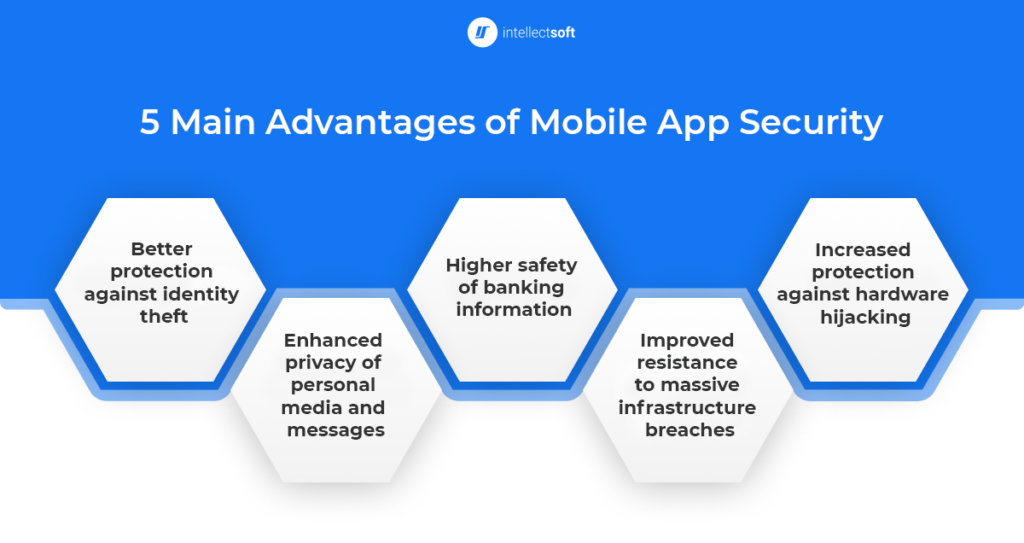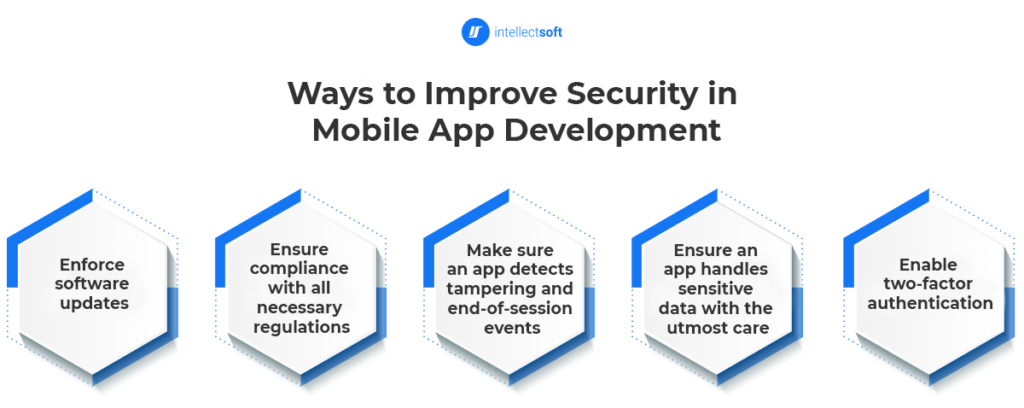Mobile app security is one of the most demanded aspects of modern software development. The reason for this is evident: mobile gadgets became an integral part of our everyday lives. They contain so much personal data, such as photos, access to email and social media accounts, payment information, and so on. Because of this, mobile app developers must use extensive measures to protect such information.
What Is Mobile App Security?
In the context of mobile applications, security refers to a specific set of measures, standards, and practices. Some of those are generic and apply to all types of devices and applications. Others are designed specifically for mobile devices and focus on their unique features, such as the presence of cameras, various sensors, GPS, etc. Mobile security features are designed to protect both hardware and software from unauthorized access, data theft, and various other threats.
Common Types of Mobile Security Threats
Considering the importance and highly personal nature of data on mobile devices, it has become the priority target of various criminals. Nowadays, smartphones are often less valuable than information that can be accessed via them. Mobile platforms usually keep users logged into their accounts even when mobile devices are turned off or put aside. This applies to most mobile applications installed on smartphones or tablets, such as email and social network clients, messengers, streaming or shopping apps, and so on.
If a thief manages to crack a password on a stolen device, such sensitive data may be used to steal the owner’s identity or simply to blackmail them, harm their reputation or try to drain their bank accounts. The same problem exists when a person loses their mobile device and a finder decides to keep it. Moreover, the information may be stolen even when the mobile device is not: a malicious software program may secretly transfer private data to a hacker.
Engineers define several categories of threats depending on their origin or targets. For example, one of the basic classifications involves passive threats and active threats.
Passive threats are vulnerabilities left in the code of a mobile application or operating system. They are potential entry points for a hacker to perform malicious actions. For example, if an application sends data without encryption or uses an outdated security protocol, it presents a potential risk.
Active threats are tools in a hacker’s arsenal. Malware, spyware, viruses, phishing web pages, and scripts are among many instruments to actively breach mobile security and steal information. They can mask themselves as harmless software or websites or may remain hidden on devices and leak personal data for months.
The Importance of Security in Mobile Applications

Considering the importance of personal data, mobile app developers put great effort into maximizing the security of their software. The adherence to mobile app security standards enhances the safety of user data. In its turn, this offers numerous benefits, some of which are listed below as examples.
5 Main Advantages of Mobile App Security
- Better protection against identity theft. To steal someone’s digital identity means to get digital copies of identification documents, a social security number, passwords to essential accounts, and other means of authentication. All this data may be obtained from a person’s mobile device, for example, by checking the internal and cloud storages or by bypassing a two-step verification using the victim’s phone number. Mobile applications designed and tested according to the newest standards have specific means to prevent this from happening.
- Higher safety of banking information. Many mobile apps that provide access to goods and services store payment information, such as credit card numbers, delivery addresses, order lists, and so on. So, a software client of your favorite taxi service, fast food chain, or online shop may potentially leak this confidential information if an app has security flaws. Proper approaches to Quality Assurance minimize such risks.
- Enhanced privacy of personal media and messages. Users usually keep many personal photos and videos directly on their mobile devices or in cloud storage accessible from said devices. If such visual media falls into the wrong hands, it can be used for blackmail or to embarrass people just out of spite. The same is true for messages that in modern mobile applications can also be in the form of photos, videos, or text. Mobile app security ensures that personal communication is encrypted and media files are hidden from intruders.
- Improved resistance to massive infrastructure breaches. Over the last decade, there have been several large-scale online breaches in global corporations where millions and even billions of data records were stolen. Usually, such enormous databases are sold in the Darknet and lead to smaller, personalized attacks, most likely scamming, phishing, and so on. As a rule, corporations are very reluctant to admit that such breaches take place, so for a while, users do not even know that their data is compromised and their privacy is in danger. Again, software built and updated according to security standards has a much higher chance to avoid data leakage during such massive events.
- Increased protection against hardware hijacking. As mobile devices become more and more advanced, they get better sensors and chips combined with powerful AI features. This makes them incredible spying tools if someone controls them remotely. They can record and transmit audio and video data, current geolocation, and other information about the device’s surroundings. Moreover, mobile devices infected with malware may become a part of a botnet that can be used for various malicious purposes, from spamming to DDoS attacks. During the cryptocurrency frenzy, smartphones and tablets were used for mining, though this tendency has declined but never disappeared completely. Mobile app security ensures that software can successfully fend off attacks and recognize infected files or malicious links to inform users in advance.
Ultimately, security in mobile app development aims to prevent all types of threats and keep users’ data and devices as safe as possible. If a mobile application is created according to modern security protocols, its users would prefer it over other similar solutions that are outdated or have known safety flaws. A secure mobile app is much more appealing because it satisfies one of the basic needs: people want to feel safe not only physically but also in terms of their privacy and finances.
Ways to Improve Security in Mobile Application Development
Mobile app security is an ongoing race. Hackers’ methods and tools have become more sophisticated, and security measures have to evolve to match those. Such measures are adopted by the software development community and include specified standards and methods to organize the development process. So, the best way to ensure the safety of a mobile app is to follow the existing guidelines and satisfy the standard requirements.
By far, the dominant security standard in the field of mobile app development is provided by the Open Worldwide Application Security Project (OWASP) foundation. It is continuously amended and improved by a worldwide community of professionals. The OWASP Mobile Application Security initiative includes three components.
The Mobile Application Security Verification Standard (MASVS) lists numerous requirements for mobile software. The testing guide (MASTG) describes the proper procedures, methods, and tools for mobile applications security testing. Conveniently, this guide comes with several illustrative test cases as references. The mobile app security checklist is a handy tool that is available in the form of PDF files in various languages. It lists all 80+ requirements of the MASVS and matches them with the appropriate test cases of MASTG.

Such an impressive amount of criteria means that the standard is very strict. Developers have to put a lot of time and effort to satisfy all the requirements and maximize the security of their mobile applications. Generally, it is better to start with a few basic improvements that have a great positive effect on security, such as the following:
- Enforce software updates. Nowadays, the majority of mobile app updates improve security rather than add new functionality. An outdated application is potentially more vulnerable. It is the developers’ duty to maintain the security of an app with updates or patches and deliver them to user devices as soon as possible.
- Make sure that an application complies with local laws and industry regulations regarding security. For example, it is a widespread policy that users’ data must be kept on servers in their respective states. This means that no country should store the personal information of other countries’ citizens.
- Ensure that an application handles sensitive data with the utmost care. First and foremost, it means using encryption and secure protocols while transmitting such information. A user interface of an app should conceal private information, such as passwords or PIN codes, by default. Sharing such data with third parties must be strictly forbidden unless it is required by an app architecture. No logging of personal information must be allowed. Sensitive data must be stored in an encrypted form preferably remotely or in a “sandbox” within the app.
- Enable two-factor authentication. A combination of two different means of authentication has become a de-facto security standard for a good reason. A password and an SMS code, or a biometric scan, such as a fingerprint or face scan, and a PIN code are among the most popular combinations that are widely used in mobile devices.
- Make sure that an application recognizes tampering and end-of-session events. After a predetermined number of failed authentications, an app must lock and prevent any further attempts of breaking in. An application also must “log out” a user after a predetermined idle period.
Ensuring top-notch security in mobile applications is possible with the help of effective QA practices and comprehensive security testing. The process is exhausting, but the established standard and checklist make it somewhat easier.
Why You Should Hire Intellectsoft to Ensure Mobile App Security
Ensuring mobile app security is a highly important task. That’s why it should be assigned to skilled engineers who have the required experience and testing tools. Intellectsoft has such experts who work in well-coordinated teams and offer a wide range of mobile app development services. We perform careful, comprehensive testing and ensure the highest standards of quality and security throughout the whole development life cycle. Contact us to get a mobile software product built according to the leading quality and security standards of the industry, including OWASP, ISO, GDPR, HIPAA, and others.